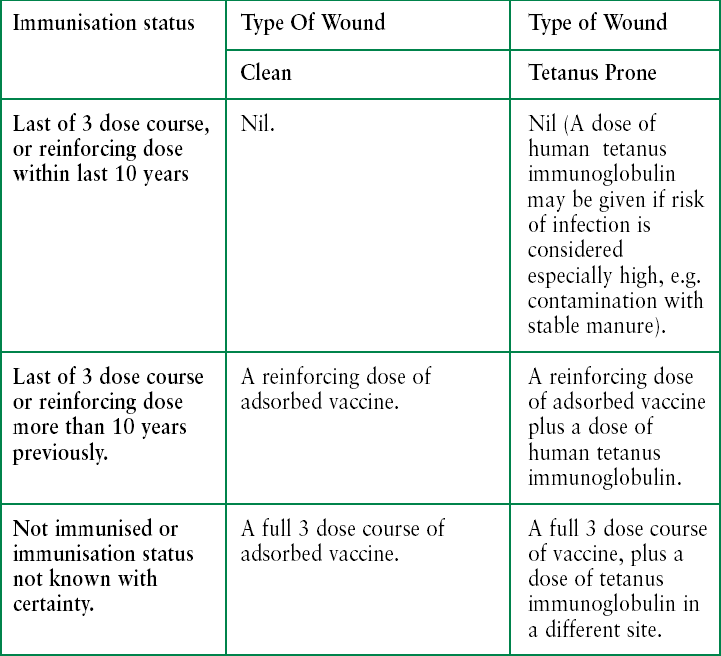Bites
Bacteriology of cat and dog bites
Most common isolate from dog (50%) and cat bites (75%) is Pasturella. (Pasteurella canis in dogs, Pasteurella multocida in cats).
Streptococci, staphylococci, Moraxella and Neisseria are common aerobic isolates.
Fusobacterium, Bacteroides, Porphyromonas and Prevotella
are
common anaerobic isolates.
Implications
For dog and cat bites should cover Pasteurella, streptococci, staphylococci and anaerobes.
Pasteurella are generally susceptible to ampicillin,
penicillins, second and third generation cephalosporins, doxycycline,
trimethoprim-sulfamethoxazole,
fluoroquinolones, clarithromycin and azithromycin.
Anti-staphylococcal penicillins, first generation cephalosporins, clindamycin and erythromycin are less active against Pasteurella in vitro.
Antibiotic choice
-
A beta-lactam antibiotic and a beta-lactamase inhibitor - "AUGMENTIN" (Co Amoxiclav)
-
Second generation cephalosporin with anaerobic activity - (cefuroxime or cefoxitin)
-
Penicillin and a first generation cephalosporin
-
Clindamycin and a fluoroquinolone.
Potential monotherapy agents
-
Azithromycin
-
Trovafloxacin
-
New ketolide antibiotics
If true Penicillin allergy avoid Erythromycin Viz Pasturella resistance, consider Cefuroxime (cross reaction noted) or in non pregnant adults Doxycycline.
Rabies
To read the Full DOH position on Rabies click here.
Click here to go to DOH site on Immunisation
The UK is considered a no risk area for Rabies. As such no post exposure vaccination is required.
For travellers returning to this country who are concerned following exposure. Information should be sought from the PHLS Virus Reference Division, London (0181-2004400); in Scotland, the Scottish Centre for Infection and Environmental Health (0141-946 7120); in Northern Ireland, the Public Health Laboratory, Belfast City Hospital (01232 329241).
Consider
Animal vaccination laws have been credited with reducing human exposure to rabies by 85% during the past three decades.
If a bite was caused by a healthy dog or cat, the animal can be confined and observed for 10 days. The bite victim does not need rabies prophylaxis if the animal remains healthy. Any illness in the animal during the 10 days requires a report to the health department and evaluation by a veterinarian.
Unprovoked bites are more likely to result in rabies.
Where the animal is not available for observation consider local Rabies risk see above link, or contact local microbiology centre.
Tetanus
Most bite wounds can be classified Tetanus prone wounds viz, Puncture wounds with crush component devitalizing tissue.
Administer Tetanus Toxoid, +- Immune globulin depending on individual vaccination status and degree of devitalized tissue.
Click Here for DOH PDF file on Tetanus prophylaxis
Click here to go to DOH site on Immunisation
 Asof 1996
Asof 1996
Dog Bites
15% to 20% of dog bite wounds become infected; however, it is not possible to predict which dog bite wounds will become infected. Signs of infection in dog bites are evident 24 hours after the bite occurs.
Cat Bites
More than half of all cat bites and scratches result in infection. Signs of infection in cat bites are evident 12 hours after the bite occurs.
Septic arthritis and osteomyelitis are seen more often with cat bites than with dog bites.
Cat-scratch disease is a possible late consequence of cat bites and scratches. The infection presents with a primary erythematous inoculation papule 3 to 10 days following the injury. The papule is followed by adenitis and fever. The infection, caused by Afipia felis and Bartonella benselae, is usually self limiting and resolves in less than 2 months. Severe infections may be treated with tetracycline.
Human Bites
Multiple species of aerobic and anaerobic bacteria, most common being:
- Viridans streptococci
- Staphylococcus aureus
- Eikenella corrodens
- Haemophilus influenzae
- Beta-lactamase-producing bacteria.
Fight Bite
The metacarpophalangeal joint is in flexion during a punch, which allows a tooth to penetrate the joint space easily. Bone, joints, or tendons are then inoculated with organisms. When the hand is extended, the tendons retract and the infection is carried beneath the skin surface. The wound looks small and the injury is often ignored until pain and infection develop.
These injuries should be aggresively managed from the start
- Local debridement
- Arthrotomy and wash out the MCP joint
- IV antibiotics.
Management of Bite Wounds
X-ray to exclude fracture or retained Foreign body
Most important is Local wound irrigation and debridement of devitalized tissue
Wound Closure- Controversial
- Clinically infected wounds, puncture wounds, and wounds older than 24 hours leave open
- If well cleaned before closure, bites of the head, neck, arms, and legs may be closed with less risk of infection.
- Hand bites should be left open or loosely approximated to allow drainage.
- If in doubt leave it open
BACTERIOLOGIC ANALYSIS OF INFECTED DOG AND CAT BITES. D. Talan et al. N Engl J Med 1999;340:85-92.